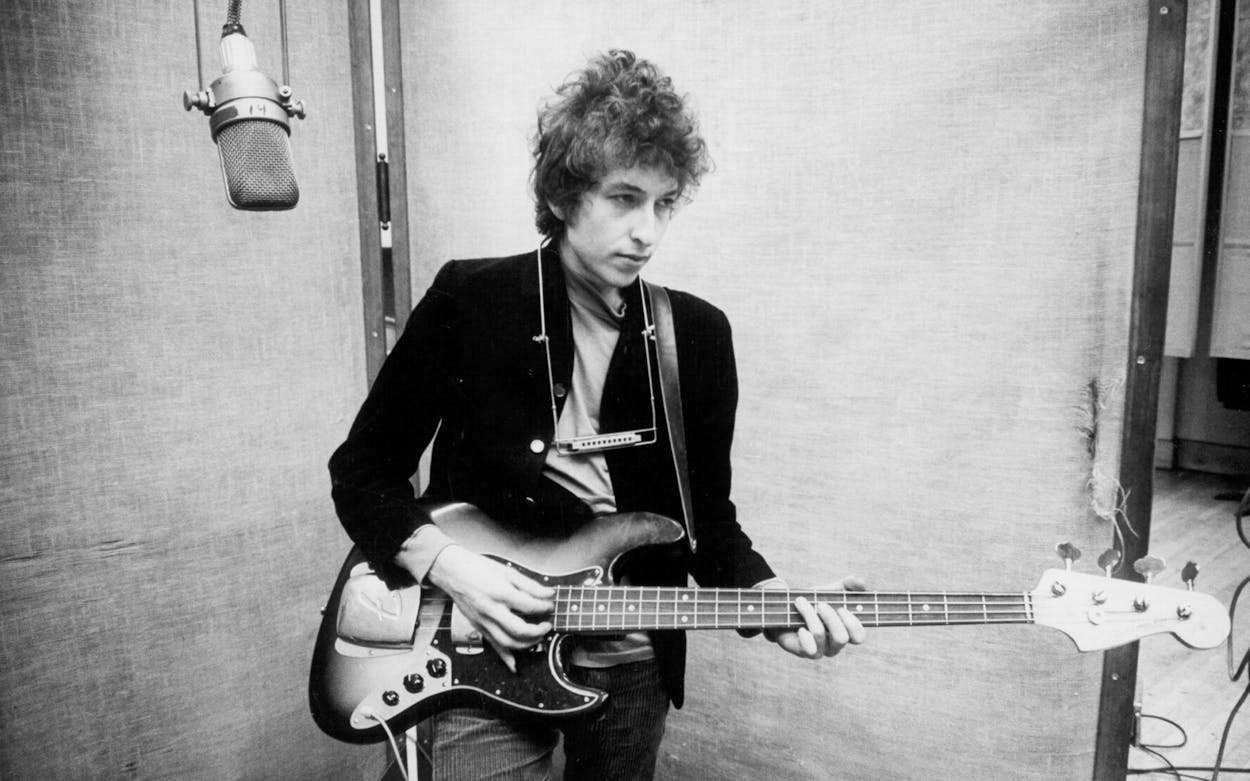Bob Dylan includes several Texans in his new book about 66 twentieth-century, mostly American pop songs that he likes.
He clearly appreciates Townes Van Zandt, observing that “One way to measure a songwriter is to look at the singers who sing their songs.” He notes that Van Zandt has been covered by the best, including Neil Young and Garth Brooks, among others. Another measure, Dylan adds, is whether a person’s songs are still performed. “Townes’s are,” he writes. “Every night—in small clubs, in lonely bedrooms, and wherever the brokenhearted watch the shadows grow long.”
In analyzing Van Zandt’s “Pancho and Lefty,” Dylan focuses on the wretched facts of the songwriter’s mental health problems. Yet, despite taking that biographical approach, he doesn’t argue that “Pancho and Lefty” is an imaginative autobiographical account of Van Zandt’s bipolar disorder—the romantic who wants to ride into the sunset yet fears that he will sell out and wind up in a cheap motel room in some cold northern city. Interestingly, Dylan selected the version of “Pancho and Lefty” recorded not by Van Zandt but by Willie Nelson and Merle Haggard—two singers, he says appreciatively, who could “sing the phone book and make you weep.” In the hands of Nelson and Haggard, Dylan writes, this song is “an epic panoramic tale, beautifully sung and beautifully produced, featuring two of the most iconic singers in the modern era.”
Willie surfaces again in Dylan’s commentary about “On the Road Again,” which is noteworthy because Dylan, like Willie, famously has been on the road pretty much nonstop for decades. The odd thing about touring, Dylan reports, is that “You never really go anywhere, you just stay in your bus, go out and perform for a few hours and move on.”
In the same vein, Dylan appreciates the rambling spirit of “Willy the Wandering Gypsy and Me” by Billy Joe Shaver, who came from Corsicana, and who Dylan once mentioned in one of his own songs, “I Feel a Change Comin’ On.” “This is a riddle of song,” Dylan writes, and he does indeed seem puzzled by how it has grabbed him. Listening to Roy Orbison’s “Blue Bayou,” Dylan admires “the operatic swoop” of the voice of the singer, who grew up in Wink, west of Odessa. And “I’ve Always Been Crazy,” by Waylon Jennings of Littlefield, leads Dylan to the insightful comment that “A love song can hide all sorts of other emotions, like anger and resentment.”
A sixth Texas-related song that Dylan highlights is Marty Robbins’s 1959 ballad “El Paso,” about a naive cowpoke who falls in love with Feleena, a dancer at Rosa’s Cantina. His conclusion here is a bit odd: “In a way this is a song of genocide, where you’re led by your nose into a nuclear war, ground zero, New Mexico where the first atom bomb was tested.” This feels too much of a stretch. The cowboy indeed rides to New Mexico, but to get away from trouble, not to find it. What in the song is the stand-in for the bomb? Dylan’s weighty metaphor smothers a classic love story.
Dylan doesn’t write about himself in this book—at least directly, but sometimes indirectly. I would argue that his commentary on Robbins’s song is an example of this. I don’t think “El Paso” is remotely about the development of the atom bomb, but I suspect that Dylan’s ballad “Señor (Tales of Yankee Power)” actually is, especially given that 1978 song’s subtitle. The lyrics of “Señor” are ambiguous, but Dylan’s narrator seems to be one of two aging banditos who are riding in the New Mexico mountains on July 16, 1945, when by chance they witness the “Trinity” test explosion of the atom bomb, just to the west of them. Dylan doesn’t say this explicitly in the song, but he does have one of the men asking the other, in a couplet with a memorable rhyme, “Can you tell me where we’re headin’ / Lincoln County Road or Armageddon?” There’s a hint right there: Lincoln County, New Mexico, lies immediately east of the Trinity test site.
Reading this book felt to me like riding with Dylan in his tour bus late at night after one of his shows. I imagine that Dylan is sipping a good red wine from California and holding forth about some of his favorite songs and singers. He expresses respect for the singer Rick Nelson and the guitarist Ry Cooder. And he loves Frank Sinatra.
On the other hand, he airily rejects pretty much the entire roster of influential musicians who recorded for Chess Records. “Out of all the artists on Chess, he [Little Walter] might have been the only one with real substance,” Dylan asserts. That’s an amazing dismissal of Chuck Berry, Buddy Guy, Willie Dixon, Bo Diddley, Muddy Waters and Howlin’ Wolf. On top of that, the book stumbles into several minor but odd historical inaccuracies, as when Dylan misstates the year when the U.S. government executed 38 Santee Sioux Indians in Minnesota.
But that may just be the second or third bottle of wine talking as the miles roll by under the wheels of his tour bus. Perhaps he is making the point that this book is not about facts but about his opinions. “The thing about being on the road is that you’re not bogged down by anything,” Dylan writes. “You give pleasure to other people and you keep your grief to yourself.”
- More About:
- Music






